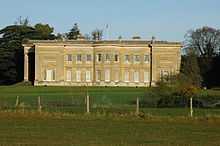Spetchley Park

Spetchley Park in the hamlet of Spetchley, near Worcester, England, has belonged to the Berkeley family, who also own Berkeley Castle in Gloucestershire, since it was first built in 1606.
The original house was burned down on the eve of the battle of Worcester, 1651, by disgruntled drunk Scottish Presbyterian Royalists to prevent Oliver Cromwell from using the house for his headquarters. All that is left from the Tudor house is part of the moat. After the fire Robert Berkeley converted the stables into living accommodation, and when the family fortunes improved the present Palladian house was built of Bath stone in 1811, to designs by the Catholic architect John Tasker.[1]
Today, in the garden at Spetchley very little has changed since Ellen Willmott’s day. It is a garden of contrasts: there are walled gardens, a melon yard with its original glasshouses, a horse pool, Victorian conservatory, a delightful Root House’, statues, fountains, architectural follies, rose gardens, lakes and bridges, superb herbaceous borders and magnificent specimen trees.
A famous regular visitor to Spetchley was the composer Edward Elgar, who had gone to a Catholic school on the estate and in later years stayed at Spetchley many times, living in the Garden Cottage. The pine trees nearby are called "Elgar's Pines" and according to his inscription for his hosts in their copy of the score, they inspired him to write parts of The Dream of Gerontius.[2]
In 1940, during World War II, Spetchley was earmarked to be used by Winston Churchill and the Cabinet in the event of London becoming too dangerous during the Blitz, or a successful invasion by the Germans and the subsequent loss of London.[3] After the Battle of Britain, Spetchley was instead used by the USAAF 8th Air Force as a place of recuperation for its pilots[4] – a basketball court was put up on the front lawn.
Every December the garden is lit for the annual Illuminated Trail,[5] when the gardens are transformed into an illuminated winter-evening walk. Hundreds of lights and special effects make this a very popular evening, attracting 10,000 people each year to this ten-night event.
See also
References
- ↑ John Tasker (c. 1738-1816) was a Roman Catholic "who worked chiefly for Catholic clients", according to Howard Colvin, A Biographical Dictionary of British Architects, 1600-1840 3rd ed. 1995, s.v. "Tasker, John"; Colvin also recorded designs for improvements at Spetchley exhibited at the Royal Academy by George Byfield, 1807. (Colvin, s.v. "Byfield, George").
- ↑ Matthew Riley, "Rustling Reeds and Lofty Pines: Elgar and the Music of Nature", 19th-Century Music 26. 2 (Autumn 2002:155-177) p. 164f.
- ↑ [ Ben Fenton, "A Brideshead hideaway for princesses at war" TelegraphCo.uk], quoting recently released National Archives documents at Kew; [http://www.spetchleygardens.co.uk/stories.html Spetchley Park Gardens
- ↑ A photograph of officers assembled in front of the portico.
- ↑ "Spetchley Gardens Illuminated Trail". Retrieved 2007-11-13.
External links
Coordinates: 52°10′57″N 2°09′07″W / 52.182596°N 2.152076°W